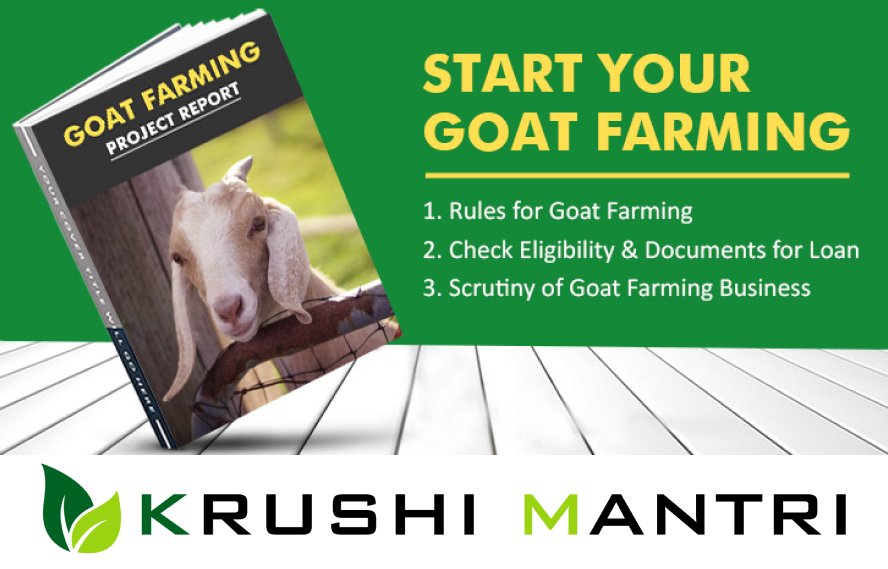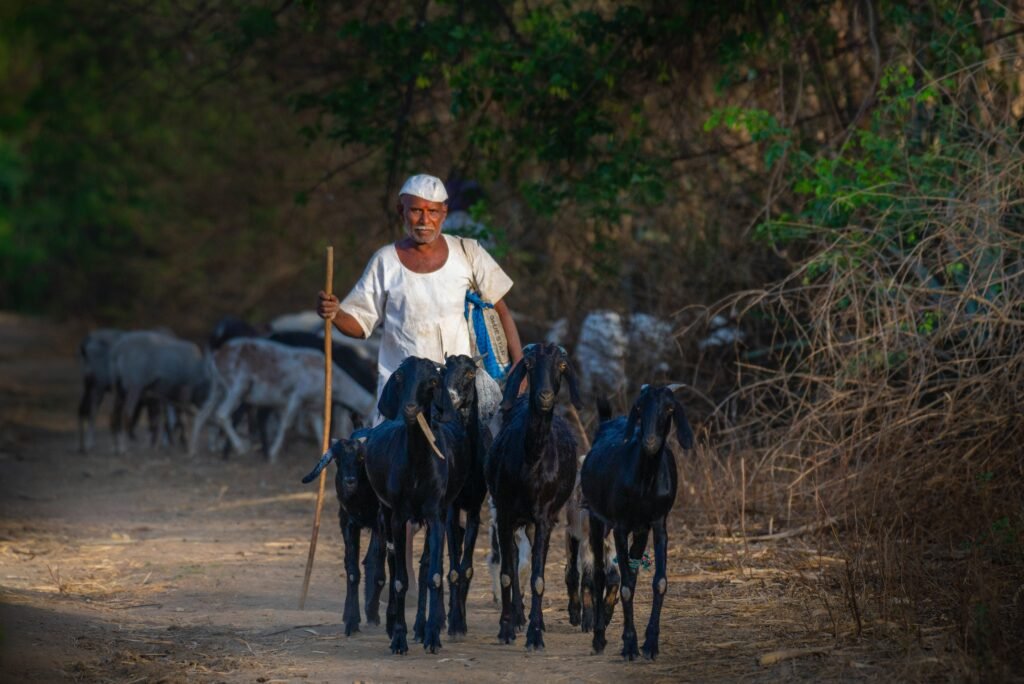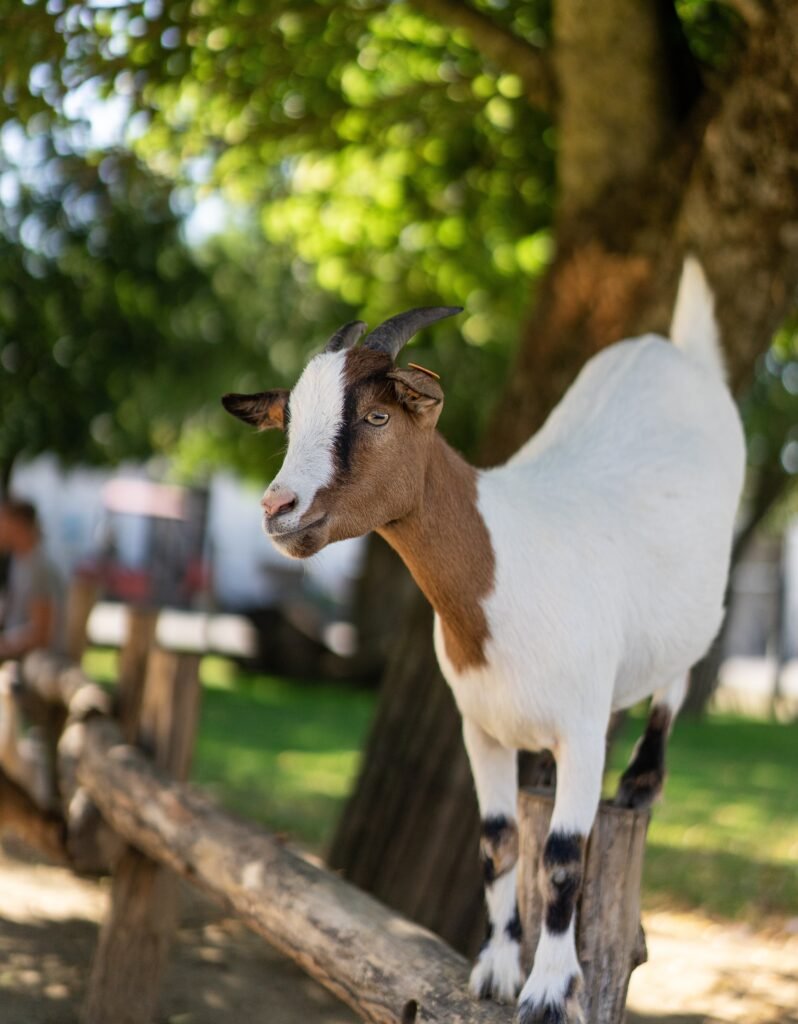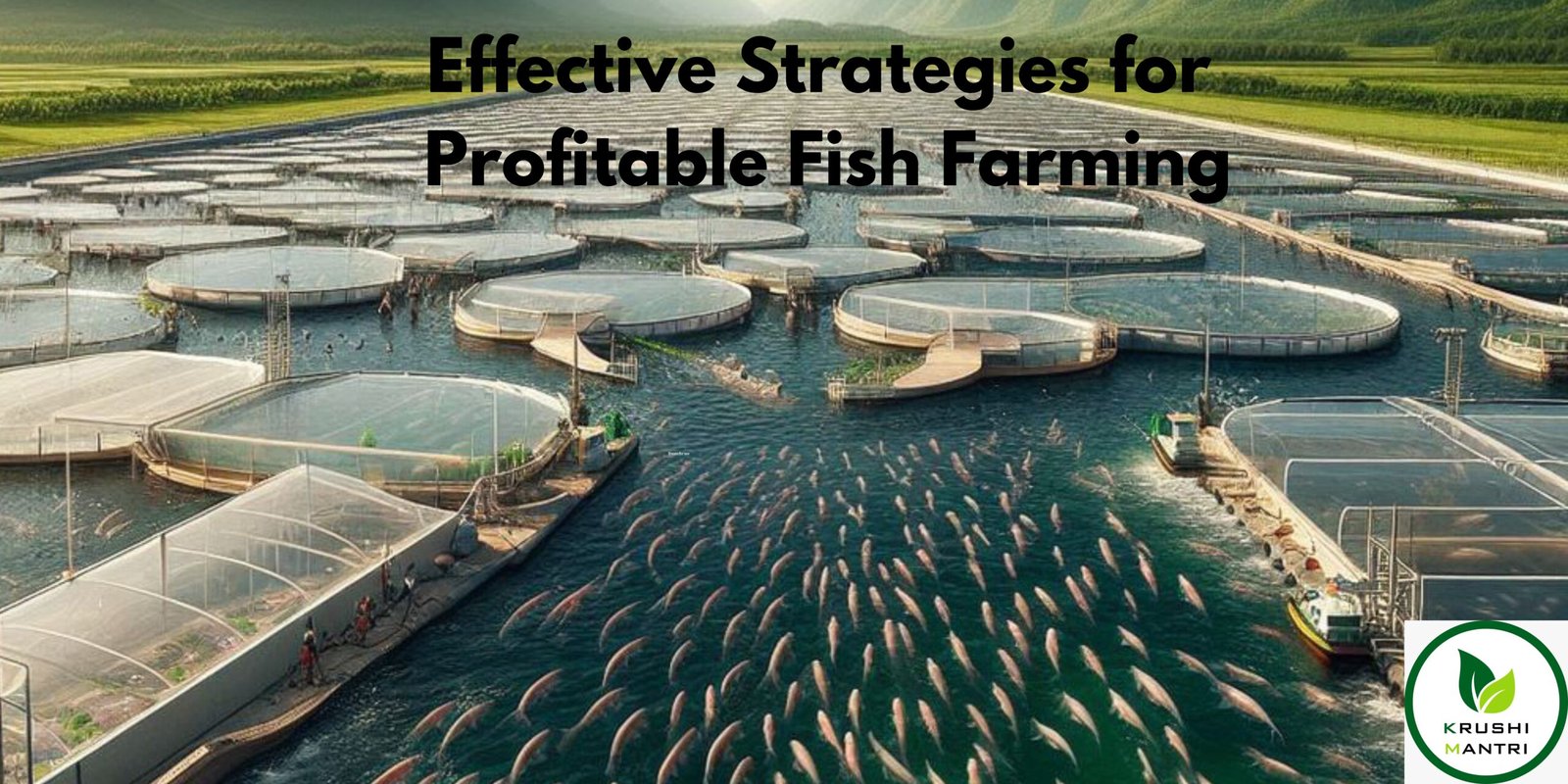Get Your Goat: Discover the Secrets to Profitable Goat Farming
Welcome to my blog, I am Krushimantri, and today I will share my experience and knowledge about the lucrative business of goat farming. Starting a goat farming business can be a profitable venture for farmers and livestock owners, but it’s important to consider the financial requirements before diving in. That’s why in this post, we will discuss the Goat Farming Project Report, which outlines a goat farming business plan and provides estimates of expenses and income. This information will help those interested in goat farming to get a better idea of the financial requirements involved.
In addition to financial considerations, obtaining loans and grants for goat rearing can also be a challenge for farmers due to a lack of information. That’s why we will also provide guidance on how to secure goat farming loans and grants from the government, including information on the government’s mandate to include he-goats in the project. Our project report will cover the rearing of 100 goats and 5 he-goats, which is a manageable number for farmers looking to start their goat farming business.
So, if you’re interested in goat farming and want to learn more about the financial requirements and government support available, keep reading! By the end of this post, you’ll have a better understanding of the potential for profitability in goat farming and how to get started on your own goat farming project. And don’t miss the powerful truth at the end that will leave you wanting more.

Goat Farming Project Report for Goat Farming Subsidy
“Goat farming project report for bank loan / subsidy for goat farming”
As someone who has ventured into goat farming in India, I can attest that obtaining a loan for this type of business can be challenging. However, with a comprehensive business plan or project report, it can be much easier to secure funding. This also applies to other livestock ventures like cow rearing, buffalo rearing, and sheep rearing.
When preparing a project report for goat farming, it is crucial to provide detailed information about the land where the goats will be reared. Whether you own the land or rent it, you must outline how much of it will be used for farming and the estimated cost of constructing a shed.
In addition, the project report should include the cost of purchasing goats and he-goats, including their breed and quality. It should also provide details of the annual food requirements and the total cost of food for the goats. As a responsible farmer, you must also factor in the cost of insuring your goats, which can be done under the livestock insurance scheme.
Lastly, it is essential to consider additional expenses that may arise during the project, such as the use of machinery or other materials. Your project report should provide an overall estimate of the total cost required to establish a successful goat farm.
By presenting a thorough and detailed project report, you can increase your chances of securing a loan for your goat farming business. It takes hard work and dedication, but the benefits can be significant, both financially and in terms of personal fulfillment. If you are interested in this type of business, I encourage you to consider goat farming as a viable option.
Process of Goat Farming

In order to avail the benefits of the government subsidy scheme, one must obtain approval of this project report from the District Animal Husbandry Department. Approval of this report will make the person eligible for the subsidy. However, the amount of subsidy may vary in different states and for different classes. Usually, it is up to 50%. If one wants to take a loan for goat farming, they should provide the animal husbandry department’s project report to their bank.
The bank conducts an investigation of the person before granting the loan. Moreover, interested individuals can receive goat farming business training in India from the district animal husbandry department or any other training center. Upon completion, the trainee receives a goat farming training certificate that can be used to secure a bank loan for goat farming.
We provide project reports for the rearing of 200 goats and 10 he-goats. Farmers can modify this report according to their preferences. For instance, if they believe a component is overpriced, they can mention it in their report.
Goat Farming Project Report Rules

The focus of this project report is on the Black Bengal goat breed. The plan involves the purchase of 200 two-year-old goats and 10 he-goats. The manure generated from the goat farm can be utilized to produce fodder for the goats. However, in the unfortunate event of a goat or he-goat’s demise, it is necessary to purchase a replacement for the purpose of farming.
To avoid any confusion, it is worth mentioning that this goat farming project report uses the term “he-goat” for male goats and “goat” for female goats. We will provide a breakdown of the costs involved in starting a goat farm.
| Technical Details | |
| Goat Breed | Black Bengal |
| Number of He-goats | 10 |
| Number of goats | 200 |
| Sex Ratio | 20:1 |
| Breeding Interval | 8 Months |
| Goat Breeding Ability / Breeding | 1.5 This means a goat can produce three children in 1 year. Or, on average, you can run it with a value of 2.7. |
| The Age of The lamb Sold In The Market | 11 Months |
| Maturity Age of Goat | 10-12 Months |
| Death Rate of The Lamb | 15% |
| Percentage of Lamb | 85% |
| Goat Farming System | Semi-Intensive |
Expense Norms of Goat Farming Project Plan
Expenses for goat farming:
- Construction cost for space where goats will reside
- 10 square feet of space needed for each goat
- 15 square feet of space needed for each he-goat
- Lambs require 4 square feet of space
Other costs:
- Rs 180 per square foot of land
- Cost of food is Rs 16 per Kg
- Labour charges for the farm
- Cost of goat insurance
| Expense Norms of Project Report On Goat Farming | |
| Space in square feet / he-goat | 15 square feet |
| Space per goat | 10 square feet |
| Every lamb needs a space | 4 square feet |
| Cost of construction | Rs 180 per sq ft |
| Cost of goat farming equipment for mature goats per goat | Rs 20 |
| Cost per acre to produce green grass for goat | Rs 5000 |
| Goat feeding quantity for one month before and after breeding. per goat | 6.75 kg/per month |
| The quantity of feeding he-goats for two months in a year (Only in breeding season) | 7.5kg/per month |
| Lamb food quantity for 30 days after birth. per lamb | 3.75 kg per month |
| Price per kg of the above-mentioned food | Rs 16 |
| need for labour | 1 |
| labour wages per month | Rs 5000 |
| Goat insurance: % of the total cost of breeding goats | 5% |
| Veterinary expenditure: per year on each mature goat and He-goat | Rs.50 per year |

Goat Farming Project Expenditure
- The project report for goat farming includes several things, such as:
- Shedding
- Equipment
- Borewell Pump
- Others
- The cost per square foot of land is Rs 180.
- The total area required for the goats is 2000 square feet.
- The total area required for the lambs is 1840 square feet.
- The cost of purchasing one goat is Rs 3000.
- The cost of purchasing one he-goat is Rs 5000.
- The total area required for he-goats is 150 square feet.
| One time Capital Cost | Amount in Indian Rupee |
| Rs 180 per sq. ft., and the cost of shed 200 goats at the rate of 10 sq. ft. per goat | 3,60,000 (One goat needs 10 square feet and 200 goats need 2000 square feet, multiply 2000 by 180). |
| The cost of shedding 10 he-goats at the rate of 15 square feet per goat | 27,000 (multiplying 15 by 10 will give 150, now multiply 150 by 180) |
| For about 460 lambs, at the rate of 4 square feet per child, 1840 square feet of space is required. The cost of its shedding | 3,31,200 (Multiply 1840 by 180) |
| Cost of buying equipment like trough and bucket used in goat farming project in India | 18,000 |
| Borewell Pump With Set (Optional) | 90,000 |
| The cost of buying 200 goats at the rate of Rs 3000 per goat | 6,00,000 |
| The cost of buying 10 he-goats at the rate of Rs 5000 per he-goat | 50,000 |
| Total Capital Cost | 14,76,200 |
Goat Farming Project Working Capital
- Working Capital includes the operational cost of any project, and here we have the entire operating expenses of the goat farming business.
- The labour cost in this report is Rs 5000 per month.
- The insurance cost of the goats is equal to 5% of the total cost of purchasing goats.
- The cost of producing food for goats is Rs 5000 per acre.
- It includes feeding, vaccination, medicines, electricity charges, etc.
| Goat Farming Project Cost | Amount in Indian Rupee |
| 5000 per month as the cost of 1 Labor for one year | 60000 |
| Insurance cost 5% of the cost of buying goats, goats | 32,500 (6,50,000 × 5%) |
| The cost of feeding 200 goats during two months of breeding, feeding 6.75 kg to one goat in a month. And the rate of feed is Rs 16 per kg | 43,200 (200 goats will eat 1350 kg of food in one month and 2,700 kg of food in two months. Multiply 2,700 by 16) |
| Feeding cost of 10 he-goats for two months at the rate of 7.5 kg per month per he-goat | 2,400 (10 he-goats eat 75 kg in one month and 150 kg supplementary feed in two months. Multiply 150 by 16) |
| The cost of feeding 460 lambs in a month is 3.75 kg per month per lamb | 27,600 (460 lambs will eat 1725 kg of food in a month. Multiply 1725 by 16.) |
| 5000 per acre to produce food for goats on 4 acres of land | 20,000 |
| Vaccination, medicines and electricity charges | 26,100 |
| Total Working Cost of the Goat Farming Project | 2,11,800 |
| Total Project Cost | 14,76,200+2,11,800 = 16,88,000 |
Income Report in Goat Farming Project
| Earning Criteria from Goat Farming Project | |
| 11-month old he-goat sale rate/ per goat | Rs 2700 |
| 11 Months Goat Sale Rate/ Per Goat | Rs 2400 |
| Rate/per bag of Used Gunny Bags | Rs 10 |
| The Goat Farming Project Report does not account for income generated from fertilizers, as manure can be utilized to produce food for the goats. Additionally, the sex ratio between female and male goats is assumed to be 1:1 in this project report. manure to produce food for the goats. The sex ratio between Born goat and he-Goat is taken as 1:1. | |
Report on Year-over-Year (YoY) Headcount of Goats.

Initially, a purchase of 200 goats and 10 he-goats was made. One year later, a total of 230 goats and 230 he-goats were sold. The accompanying table presents detailed information on the goat herd.
| Year | First Year | Second Year | Third Year | Fourth Year |
| Number of goats purchased | 200 | |||
| Number of he-goats purchased | 10 | |||
| Breeding per breeding | 1.5 | 1.5 | 1.5 | 1.5 |
| Number of goats born | 270 | 270 | 270 | 270 |
| The number of he-goats born | 270 | 270 | 270 | 270 |
| Mortality rate 15% | 80 | 80 | 80 | 80 |
| The number of goats available for sale | Goats reared in the first year will be sold in the second year | 230 | 230 | 230 |
| The number of he-goats available for sale | he-Goats reared in the first year will be sold in the second year | 230 | 230 | 230 |
Summary of Goat Farming Project
To summarize, a comprehensive overview of the four-year business can be observed. This includes information on the profit and cost associated with goat farming, such as:
- The capital cost required to start the business
- The operating cost of the business
- The overall cost incurred in the business
- The revenue generated from the sale of goats, he-goats, and other relevant factors.
| Year | First Year | Second Year | Third Year | Fourth Year |
| Capital cost | Rs 14,76,200 | |||
| Working cost | 2,11,800 | 2,11,800 | 2,11,800 | 2,11,800 |
| Total cost | 16,88,000 | 2,11,800 | 2,11,800 | 2,11,800 |
| Income from goats sold | – | 230 ×2400 = 5,52,000 | 230 ×2400 = 5,52,000 | 230 ×2400 = 5,52,000 |
| Income from he-goats sold | – | 230 ×2700 = 6,21,000 | 230 ×2700 = 6,21,000 | 230 ×2700 = 6,21,000 |
| Earnings from Sold Gunny Bags | 920 | 920 | 920 | 920 |
| Total earnings | 920 | 11,73,000 | 11,73,000 | 11,73,000 |
| Total profit | -16,87,080 | 9,61,200 | 9,61,200 | 9,61,200 |
Scrutiny of Complete Business of Four Years
Total Earnings from three year (9,61,200 + 9,61,200 + 9,61,200) = 28,83,600 rupees.
How much profit in goat farming of 4 Years: {(Total Earnings – Total Expenses) (28,83,600 – 16,87,080) = Rs. 11,96,520 rupees.
Please note that this goat farming project proposal is for educational purposes only. The data provided in it may be subject to change based on various factors such as time, location, and market conditions.
We hope this blog is vital for you; hence more information regarding any agriculture sector, stay tuned with Krushimantri.com
And more information regarding any travel, stay turned with urbanchats.com
FAQ
Q1. Do goats need shelter?
Answer:-
Yes, goats need shelter to protect them from extreme weather conditions such as heavy rain, strong winds, and extreme heat or cold. A shelter also provides a safe and secure space for goats to rest, sleep and protect them from predators. The shelter can be a simple structure made of wood, bamboo, or any other locally available materials. The size of the shelter depends on the number of goats you have and the local climate conditions. The shelter should be well ventilated and kept clean and dry to prevent the spread of diseases.
Q2. What is the scope of goat farming in India?
Answer:-
Goat farming has significant potential in India due to several reasons. Firstly, goats are well adapted to the Indian climate and can survive in harsh weather conditions, making them a low-maintenance option. Secondly, goat meat and milk are widely consumed in India, providing a ready market for goat farmers. Additionally, goat manure is a valuable fertilizer, and goat farming can be integrated with other agricultural practices such as horticulture and agroforestry.
Goat farming also has the potential to provide employment opportunities and generate income for rural communities. The government of India has recognized the potential of goat farming and has launched several initiatives to promote it, such as providing subsidies for setting up goat farms, offering training and extension services, and supporting the establishment of processing and marketing infrastructure.
Overall, the scope of goat farming in India is significant, and with proper management practices, it can be a profitable and sustainable enterprise for farmers.
Q3. How to get a goat farming loan?
Answer:-
Getting a goat farming loan involves the following steps:
- Contacting the bank or financial institution: Contact the nearest bank or financial institution that offers agricultural loans, and inquire about their loan products for goat farming.
- Gathering information and documents: Get information on the required documents and eligibility criteria for the loan. You will need to provide documents such as identity proof, address proof, land documents, and other financial documents.
- Preparing a project report: Prepare a detailed project report that includes information such as the breed of goats, the number of goats, the estimated cost of the project, the expected income and expenses, and the repayment plan. The project report should also include a detailed analysis of the market demand for goat products in your area.
- Submitting the loan application: Once you have gathered all the necessary information and documents, submit the loan application along with the project report to the bank or financial institution.
- Loan approval and disbursement: The bank or financial institution will evaluate your loan application and project report. If approved, the loan amount will be disbursed to your account, and you can start your goat farming project.
It is important to note that the loan approval process may vary depending on the bank or financial institution, and it is advisable to conduct thorough research before applying for a loan.
Q4. Is goat farming a profitable business?
Answer:-
Yes, goat farming can be a profitable business if it is done with proper planning, management, and marketing strategies. Goats have a short gestation period and can multiply quickly, which means that farmers can have a large herd in a short amount of time. They are also known for their ability to adapt to different environments and feed on a variety of plants, making them a relatively low-maintenance livestock option.
In addition, goat milk, meat, and other products like cheese and soap have a growing demand in the market, which can provide farmers with additional income streams. However, profitability depends on various factors such as breed selection, proper nutrition and healthcare, market demand, and selling price. It is essential to research and plan before starting a goat farming business to ensure profitability.
Q5. How to apply for goat farming subsidy?
Answer:-
To apply for a goat farming subsidy in India, you can follow these steps:
- Check eligibility: Firstly, check if you are eligible for the subsidy. The eligibility criteria may vary depending on the state and scheme. Generally, small and marginal farmers, women farmers, and members of Scheduled Castes and Scheduled Tribes are given priority.
- Prepare a project report: Prepare a detailed project report (DPR) for your goat farming business, which includes information about the number of goats, breed, feed, shelter, and other expenses. The DPR should also include a cost-benefit analysis and a repayment plan.
- Choose a scheme: Choose a suitable scheme for your goat farming business. You can get information about various schemes from the District Animal Husbandry Department or from the official website of the Ministry of Agriculture and Farmers’ Welfare.
- Apply for the subsidy: Submit your application for the subsidy along with the DPR to the District Animal Husbandry Department or the designated bank. You may also be required to submit some additional documents such as ID proof, land ownership certificate, and bank account details.
- Approval and Disbursement: The authorities will verify your application and, if approved, the subsidy amount will be disbursed to your bank account. Make sure to follow the terms and conditions of the scheme to avoid any penalties or legal issues.
Q6. What are challenges in goat farming?
Answer:-
There are several challenges in goat farming, some of which include:
- Predators: Goats are susceptible to attacks by predators such as wild dogs, foxes, wolves, and coyotes.
- Diseases: Goats are vulnerable to various diseases like pneumonia, foot and mouth disease, and gastrointestinal diseases.
- Feed Management: Goats require proper nutrition and feed management. The cost of feed can be a significant expense for farmers.
- Marketing: Finding a reliable market for goat products can be a challenge. Many farmers struggle to find buyers who will pay a fair price for their products.
- Lack of Knowledge: Lack of knowledge and expertise in goat farming can lead to poor herd management practices and low productivity.
- Climate: Extreme weather conditions such as heat waves or prolonged periods of drought or rain can affect the health and productivity of goats.
- Cost of inputs: The cost of inputs such as veterinary services, feed, and equipment can be high, affecting the profitability of the business.
Q7. Is goat farming a profitable business or not?
Answer:-
Yes, goat farming can be a profitable business if it is done properly with good management practices. Goats are known to reproduce quickly and have a high rate of twinning or even triplets, which makes it easier to increase the size of the herd in a short time. In addition, goats can be raised on a small piece of land, making them a good option for small-scale farmers. Goat meat and milk are also in high demand and can provide a good source of income. However, like any business, there are risks involved and it is important to have proper knowledge, skills, and planning in place to ensure profitability.
Q8. What are some goat breeds for a goat farm business in India?
Answer:-
India has several breeds of goats suitable for commercial farming. Some of the popular goat breeds in India for farming are:
- Boer:- Boer goats are popular for their fast growth rate and high meat yield.
- Sirohi:- Sirohi goats are known for their adaptability to the Indian climate, high fertility rate, and good meat quality.
- Osmanabadi:- Osmanabadi goats are hardy and adaptable to arid and semi-arid regions of India, known for their good meat and milk production.
- Beetal:- Beetal goats are found in Punjab and Haryana, and are popular for their large size, high milk production, and good meat quality.
- Jamunapari:- Jamunapari goats are found in Uttar Pradesh, known for their high milk production, and are often used for crossbreeding with other breeds.
- Black Bengal:- Black Bengal goats are found in West Bengal and are known for their adaptability, hardiness, and low feed requirements.
- Barbari:- Barbari goats are found in Uttar Pradesh, Rajasthan, and Gujarat, and are known for their fast growth, good meat quality, and adaptability.
It is important to select a breed that is suitable for the climate and region, as well as the market demand for meat, milk, or both.










0 thoughts on “Profitable Goat Farming: An Investment Guide to Expenses and Earnings – No.1 Project Report”